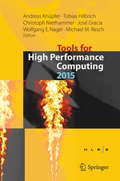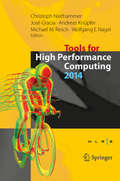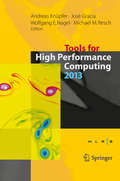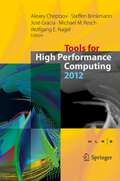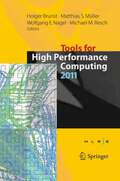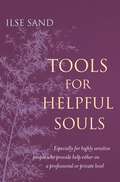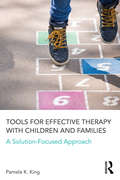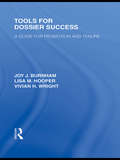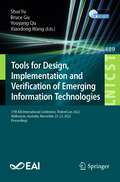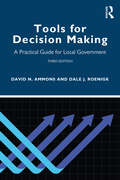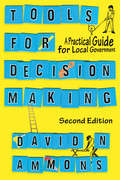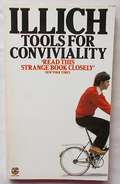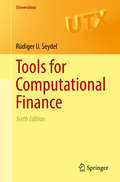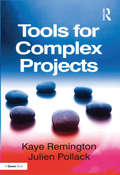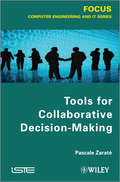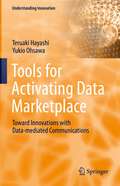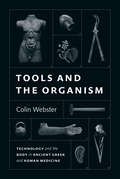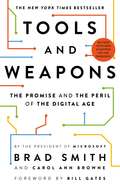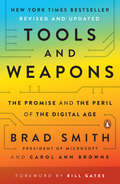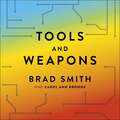- Table View
- List View
Tools for High Performance Computing 2015
by Andreas Knüpfer Tobias Hilbrich Christoph Niethammer José Gracia Wolfgang E. Nagel Michael M. ReschHigh Performance Computing (HPC) remains a driver that offers huge potentials and benefits for science and society. However, a profound understanding of the computational matters and specialized software is needed to arrive at effective and efficient simulations. Dedicated software tools are important parts of the HPC software landscape, and support application developers. Even though a tool is by definition not a part of an application, but rather a supplemental piece of software, it can make a fundamental difference during the development of an application. Such tools aid application developers in the context of debugging, performance analysis, and code optimization, and therefore make a major contribution to the development of robust and efficient parallel software. This book introduces a selection of the tools presented and discussed at the 9th International Parallel Tools Workshop held in Dresden, Germany, September 2-3, 2015, which offered an established forum for discussing the latest advances in parallel tools.
Tools for High Performance Computing 2014
by Andreas Knüpfer Christoph Niethammer José Gracia Wolfgang E. Nagel Michael M. ReschNumerical simulation and modelling using High Performance Computing has evolved into an established technique in academic and industrial research. At the same time, the High Performance Computing infrastructure is becoming ever more complex. For instance, most of the current top systems around the world use thousands of nodes in which classical CPUs are combined with accelerator cards in order to enhance their compute power and energy efficiency. This complexity can only be mastered with adequate development and optimization tools. Key topics addressed by these tools include parallelization on heterogeneous systems, performance optimization for CPUs and accelerators, debugging of increasingly complex scientific applications and optimization of energy usage in the spirit of green IT. This book represents the proceedings of the 8th International Parallel Tools Workshop, held October 1-2, 2014 in Stuttgart, Germany - which is a forum to discuss the latest advancements in the parallel tools.
Tools for High Performance Computing 2013
by Andreas Knüpfer José Gracia Wolfgang E. Nagel Michael M. ReschCurrent advances in High Performance Computing (HPC) increasingly impact efficient software development workflows. Programmers for HPC applications need to consider trends such as increased core counts, multiple levels of parallelism, reduced memory per core, and I/O system challenges in order to derive well performing and highly scalable codes. At the same time, the increasing complexity adds further sources of program defects. While novel programming paradigms and advanced system libraries provide solutions for some of these challenges, appropriate supporting tools are indispensable. Such tools aid application developers in debugging, performance analysis, or code optimization and therefore make a major contribution to the development of robust and efficient parallel software. This book introduces a selection of the tools presented and discussed at the 7th International Parallel Tools Workshop, held in Dresden, Germany, September 3-4, 2013.
Tools for High Performance Computing 2012
by José Gracia Wolfgang E. Nagel Michael M. Resch Alexey Cheptsov Steffen BrinkmannThe latest advances in the High Performance Computing hardware have significantly raised the level of available compute performance. At the same time, the growing hardware capabilities of modern supercomputing architectures have caused an increasing complexity of the parallel application development. Despite numerous efforts to improve and simplify parallel programming, there is still a lot of manual debugging and tuning work required. This process is supported by special software tools, facilitating debugging, performance analysis, and optimization and thus making a major contribution to the development of robust and efficient parallel software. This book introduces a selection of the tools, which were presented and discussed at the 6th International Parallel Tools Workshop, held in Stuttgart, Germany, 25-26 September 2012.
Tools for High Performance Computing 2011
by Wolfgang E. Nagel Michael M. Resch Matthias S. Müller Holger BrunstThe proceedings of the 5th International Workshop on Parallel Tools for High Performance Computing provide an overview on supportive software tools and environments in the fields of System Management, Parallel Debugging and Performance Analysis. In the pursuit to maintain exponential growth for the performance of high performance computers the HPC community is currently targeting Exascale Systems. The initial planning for Exascale already started when the first Petaflop system was delivered. Many challenges need to be addressed to reach the necessary performance. Scalability, energy efficiency and fault-tolerance need to be increased by orders of magnitude. The goal can only be achieved when advanced hardware is combined with a suitable software stack. In fact, the importance of software is rapidly growing. As a result, many international projects focus on the necessary software.
Tools for Helpful Souls: Especially for highly sensitive people who provide help either on a professional or private level
by Ilse SandHighly sensitive people spend a lot of time trying to balance their surroundings, including the emotions and wellbeing of those around them, which lends to a supportive and caring nature. While highly sensitive people are well-suited for the role of 'helper', this practice can be particularly exhausting if not regulated. This book contains a variety of tools geared towards self-development and optimising a helpful and supportive conversation in professional therapeutic settings or personal relationships. This practical guide demonstrates how to use simple psychotherapeutic methods through supportive dialogues, which can be applied by anyone without any formal training. Written in easy language with real-life examples and practical exercises, this will serve as a handbook for highly sensitive people who provide help either on a professional or personal level.
Tools for Foresight: Planning for the Unpredictable Future
by Arie De GeusThough you can't predict the future, this chapter illustrates how future success depends on understanding the multiple ways the future could unfold.
Tools for Evaluating the Metropolitan Medical Response System Program: Phase I Report
by Committee on Evaluation of the Metropolitan Medical Response ProgramInformation on the Tools for Evaluating the Metropolitan Medical Response System Program
Tools for Effective Therapy with Children and Families: A Solution-Focused Approach
by Pamela K. KingTools for Effective Therapy with Children and Families provides mental health professionals with step-by-step tools and strategies for effective therapeutic outcomes with children and their families. An integration of solution-focused brief therapy and play therapy, this groundbreaking book is uniquely suited to clinicians working with school-aged children and their parents. Tools for Effective Therapy with Children and Families uses clearly articulated and creative play activities to elicit conversations about solutions, successes, and collaborative goals with clients. Session transcripts and technique illustrations throughout the chapters allow clinicians to see the solution-focused approach in action.
Tools for Dossier Success: A Guide for Promotion and Tenure
by Lisa M. Hooper Joy J. Burnham Vivian H. WrightTools for Dossier Success demystifies the dossier process from start to finish. Written for faculty members at different points in their academic trajectory, this is a practical, step-by-step guide to planning, creating, and polishing the best possible representation of accumulated evidence and accomplishments in teaching, research, and service. The "how to" information offered here is essential for those seeking tenure or promotion from associate professor to professor, senior faculty serving as mentors, and graduate students planning an entrance into academia. Key features include: Relevant and useful information for faculty in diverse disciplines and settings A comprehensive six-step model to ensure the best representation of one’s work Tips and suggestions to help avoid common pitfalls Best practice examples from successful tenured faculty Steps for seeking out assistance from other faculty, mentors, and peers A balanced review of the "ups and downs" of the tenure process
Tools for Design, Implementation and Verification of Emerging Information Technologies: 18th EAI International Conference, TRIDENTCOM 2023, Nanjing, China, November 11-13, 2023, Proceedings (Lecture Notes of the Institute for Computer Sciences, Social Informatics and Telecommunications Engineering #523)
by Xinyi Huang Lei Xu Jianghua LiuThis book constitutes the refereed post-conference proceedings of the 18th EAI International Conference on Tools for Design, Implementation and Verification of Emerging Information Technologies, TridentCom 2023, which was held in Nanjing, China, during November 11-13, 2023. The 9 full papers were selected from 30 submissions and deal the emerging technologies of big data, cyber-physical systems and computer communications. The papers are grouped in thematical sessions on blockchain and its applications; emerging applications; AI and its security.
Tools for Design, Implementation and Verification of Emerging Information Technologies: 17th EAI International Conference, TridentCom 2022, Melbourne, Australia, November 23-25, 2022, Proceedings (Lecture Notes of the Institute for Computer Sciences, Social Informatics and Telecommunications Engineering #489)
by Xiaodong Wang Shui Yu Bruce Gu Youyang QuThis book constitutes the refereed post-conference proceedings of the 17th EAI International Conference on Tools for Design, Implementation and Verification of Emerging Information Technologies, TridentCom 2022, which was held in Melbourne, Australia, in November 23-25,2022. The 11 full papers were selected from 30 submissions and deal the emerging technologies of big data, cyber-physical systems and computer communications. The papers are grouped in thematical sessions on network security; network communication; network services; mobile and ad hoc networks; blockchain; machine learning.
Tools for Design, Implementation and Verification of Emerging Information Technologies: 15th EAI International Conference, TridentCom 2020, Virtual Event, November 13, 2020, Proceedings (Lecture Notes of the Institute for Computer Sciences, Social Informatics and Telecommunications Engineering #380)
by Zijian Zhang Yuyu Yin Yu Weng Li KuangThis book constitutes the refereed post-conference proceedings of the 15th EAI International Conference on Tools for Design, Implementation and Verification of Emerging Information Technologies, TridentCom 2020. Due to COVID 19 pandemic the conference was held virtually. The 12 full papers were selected from 32 submissions and deal the emerging technologies of big data, cyber-physical systems and computer communications. The papers are grouped in thematical sessions on computer network and testbed application as well as analytics for big data of images and test.
Tools for Decision Making: A Practical Guide for Local Government
by David N. Ammons Dale J. RoenigkThis book guides readers to the mastery of a wide array of practical analytic techniques useful to local governments. Written in an easy-to-read style with an emphasis on providing practical assistance to students, local government practitioners, and others interested in local government performance, this updated third edition features analytic methods selected for their relevance to everyday problems encountered in city and county governments. The authors outline a variety of practical techniques including the simplest that the fields of management, public administration, policy analysis, and industrial engineering have to offer. Each analytic technique is introduced in the context of a fictitious case presented over a few pages at the beginning of that technique’s chapter. Contents include demand analysis, work distribution analysis, process flow-charting, inflation adjustments, annualizing capital costs, staffing analysis, identifying full costs of a program or service, present value analysis, life-cycle costing, lease/buy analysis, cost-effectiveness analysis, benchmarking analysis, and more. This updated third edition features a dramatic expansion of Excel-based applications, plus templates and exercises accompanying many of the chapters and available online. New chapters prepare readers to: • use statistical tests to identify significant differences in performance averages; • construct Pareto charts; • develop cause-and-effect diagrams; • prepare control charts; • detect possible discrimination in hiring and appointment practices; and • present analytic evidence more effectively. This book is an essential resource for students and instructors of public administration courses on analysis, methods, evaluation, productivity improvement, and service delivery. Online resources for this book, including Excel templates, are available at https://toolsfordecisionmaking.sog.unc.edu
Tools for Decision Making: A Practical Guide for Local Government
by David N. AmmonsKnown for encouraging step-by-step problem solving and for connecting techniques to real-world scenarios, David Ammons’ Tools for Decision Making covers a wide range of local government practices—from the foundational to the advanced. Brief and readable, each chapter opens with a problem in a hypothetical city and then introduces a tool to address it. Thoroughly updated with new local government examples, the second edition also incorporates chapters devoted to such additional techniques as sampling analysis, sensitivity analysis, financial condition analysis, and forecasting via trend analysis. Numerous tables, figures, exhibits, equations, and worksheets walk readers through the application of tools, and boxed features throughout each chapter present other uses for techniques, helpful online resources, and common errors. A handy guide for students and an invaluable resource and reference for practitioners.Students can visit college.cqpress.com/TDM for more opportunities to put these tools to use. Instructors can register for access to the solutions.
Tools for Conviviality
by Ivan IllichA work of seminal importance, this book presents Ivan Illich's penetrating analysis of the industrial mode of production which characterises our contemporary world. The conviviality for which noted social philosopher Ivan Illich is arguing is one in which the individual's personal energies are under direct personal control and in which the use of tools is responsibly limited. This book claims out attention for the urgency of its appeal, the stunning clarity of its logic and the overwhelmingly human note that it sounds.
Tools for Computational Finance
by Rüdiger U. SeydelComputational and numerical methods are used in a number of ways across the field of finance. It is the aim of this book to explain how such methods work in financial engineering. By concentrating on the field of option pricing, a core task of financial engineering and risk analysis, this book explores a wide range of computational tools in a coherent and focused manner and will be of use to anyone working in computational finance. Starting with an introductory chapter that presents the financial and stochastic background, the book goes on to detail computational methods using both stochastic and deterministic approaches.Now in its sixth edition, Tools for Computational Finance has been significantly revised and contains: Several new parts such as a section on extended applications of tree methods, including multidimensional trees, trinomial trees, and the handling of dividends;Additional material in the field of generating normal variates with acceptance-rejection methods, and on Monte Carlo methods;115 exercises, and more than 100 figures, many in color.Written from the perspective of an applied mathematician, all methods are introduced for immediate and straightforward application. A ‘learning by calculating’ approach is adopted throughout this book, enabling readers to explore several areas of the financial world.Interdisciplinary in nature, this book will appeal to advanced undergraduate and graduate students in mathematics, engineering, and other scientific disciplines as well as professionals in financial engineering.
Tools for Complex Projects
by Kaye Remington Julien PollackTraditional project management approaches assume that project contexts are unchanging and key factors, though complicated, are reducible to unambiguous elements for management and control. Whilst this assumption has simplified the task for writers and educators, it is increasingly being recognised that these techniques do not work in projects which may be described as complex (due to their size, technical difficulties, conflicting environmental and political constraints or poorly understood or shared goals). Tools for Complex Projects draws on research in the areas of project management, complexity theory and systems thinking to provide a ready reference for understanding and managing the increasing complexity of projects and programmes. The main part of the book provides a series of fourteen project tools. Some of these tools may be used at the level of the whole project life-cycle. Others may be applied ad hoc at any time. In each case, the authors provide: detailed guidelines for using the tool, information on its purpose and the types of complexity for which it is most appropriate, the theoretical background to the tool, a practical example of its use, and any necessary words of caution. This is an example of advanced project management at work; sophisticated tools that require a level of project and management expertise and offer rigorous and highly practical methods for understanding, structuring and managing the most complex of projects.
Tools for Collaborative Decision-Making (Focus Ser.)
by Pascale ZaratéDecision-making has evolved recently thanks to the introduction of information and communication technologies in many organizations, which has led to new kinds of decision-making processes, called “collaborative decision-making”, at the organizational and cognitive levels. This book looks at the development of the decision-making process in organizations. Decision-aiding and its paradigm of problem solving are defined, showing how decision-makers now need to work in a cooperative way. Definitions of cooperation and associated concepts such as collaboration and coordination are given and a framework of cooperative decision support systems is presented, including intelligent DSS, cooperative knowledge-based systems, workflow, group support systems, collaborative engineering, integrating with a collaborative decision-making model in part or being part of global projects. Several models and experimental studies are also included showing that these new processes have to be supported by new types of tools, several of which are described in order to calculate or simulate solutions or global solutions for decision-making modification. Definitions and new trends for these models are given, along with types of systems. Contents 1. Alteration of Decision-Making Processes in Organizations. 2. New Decision-Making Processes. 3. The Need to Cooperate. 4. Cooperative Decision-Making. 5. Activity Support Systems. 6. Cooperative Decision Support Systems: CDSSS. About the Authors Pascale Zaraté is Professor at Toulouse 1 Capitole University, France. She conducts her research at the IRIT Laboratory and is the Editor-in-Chief of the International Journal of Decision Support Systems Technologies. She is co-chair of the European Working Group on DSS and has published several studies and books.
Tools for Activating Data Marketplace: Toward Innovations with Data-mediated Communications (Understanding Innovation)
by Yukio Ohsawa Teruaki HayashiThis book explores the employment of market mechanisms for data-interactive innovations. Based on the concept of innovators' marketplaces the book introduces a new concept of 'data jackets' to enable analysis of what kind of data exist, where they are located, and what kind of information they hold, even if the contents of data cannot be made publicly available.The book presents the concept of a marketplace for data in the case of data-interactive innovations. It introduces the marketplace as a platform for value-based exchange of data and - based on the idea of the innovators' marketplace - explains how data jackets can be utilized independently from the actual contents of the data. Specific chapters deepen the understanding of variables, constraints and intentions as constituent parts of data jackets, and the extension to variable quest, a process towards the design of data. A number of case studies showcases how the methods and processes presented can be employed in real-life contexts. Finally the authors present some extensions of the concept for web-based IMDJ and connections to business information system and an outlook.
Tools for Achieving Strategic Speed: Assessing Your Own and Your Organization's Strengths and Weaknesses and Determining Your Next Steps
by Henry M. Frechette Edwin H. Boswell Jocelyn R. DavisStrategic speed is not about concocting brilliant strategies. It's about leaders who know how to accelerate strategy execution by adopting the right mind-set and taking the right actions-actions focused on mobilizing people. Strategic speed is where urgency meets execution, and that means you don't need to go into a bunker and spend months drawing up complex plans in order to see results. If you as a leader can think and behave in speed-promoting ways, your strategies can gain immediate traction. So where do you begin? In this chapter, the authors, all of whom are executives at The Forum, a global consulting firm, provide you with four tools for achieving strategic speed: the Time/Value Assessment, which will give you a visual sense of the strategic speed currently being achieved in your business unit; the Team Survey, a ten-minute questionnaire you can send out to members of your team or business unit that will tell you exactly how clear, unified, and agile they feel with regard to your strategic initiatives and enable you to identify trouble spots; the Leadership Profile, which will help you diagnose your organization's strengths and weaknesses in four key leadership practices; and the Speed Matrix, which will help you pull all the information together and prioritize your next steps in mobilizing your people and accelerating execution. This chapter was originally published as Chapter 7 of "Strategic Speed: Mobilize People, Accelerate Execution."
Tools and the Organism: Technology and the Body in Ancient Greek and Roman Medicine
by Colin WebsterThe first book to show how the concept of bodily organs emerged and how ancient tools influenced conceptualizations of human anatomy and its operations. Medicine is itself a type of technology, involving therapeutic tools and substances, and so one can write the history of medicine as the application of different technologies to the human body. In Tools and the Organism, Colin Webster argues that, throughout antiquity, these tools were crucial to broader theoretical shifts. Notions changed about what type of object a body is, what substances constitute its essential nature, and how its parts interact. By following these changes and taking the question of technology into the heart of Greek and Roman medicine, Webster reveals how the body was first conceptualized as an “organism”—a functional object whose inner parts were tools, or organa, that each completed certain vital tasks. He also shows how different medical tools created different bodies. Webster’s approach provides both an overarching survey of the ways that technologies impacted notions of corporeality and corporeal behaviors and, at the same time, stays attentive to the specific material details of ancient tools and how they informed assumptions about somatic structures, substances, and inner processes. For example, by turning to developments in water-delivery technologies and pneumatic tools, we see how these changing material realities altered theories of the vascular system and respiration across Classical antiquity. Tools and the Organism makes the compelling case for why telling the history of ancient Greco-Roman medical theories, from the Hippocratics to Galen, should pay close attention to the question of technology.
Tools and Weapons: The Promise and the Peril of the Digital Age
by Brad Smith Carol Ann Browne*THE INSTANT NEW YORK TIMES BESTSELLER AND WORLD ECONOMIC FORUM BOOK CLUB PICK*'A clear, compelling guide to some of the most pressing debates in technology today.' Bill Gates, from the foreword'The de facto ambassador for the technology industry at large.' The New York Times'One of the few executives willing to speak openly about the industry's most vexing issues.' Sunday Times__________Microsoft President Brad Smith operates by a simple core belief: when your technology changes the world, you bear a responsibility to help address the world you have helped create. This might seem uncontroversial, but it flies in the face of a tech sector long obsessed with rapid growth and sometimes on disruption as an end in itself. While sweeping digital transformation holds great promise, we have reached an inflection point. The world has turned information technology into both a powerful tool and a formidable weapon, and new approaches are needed to manage an era defined by even more powerful inventions like artificial intelligence. Companies that create technology must accept greater responsibility for the future, and governments will need to regulate technology by moving faster and catching up with the pace of innovation.In Tools and Weapons, Brad Smith and Carol Ann Browne bring us a captivating narrative from the cockpit of one of the world's largest and most powerful tech companies as it finds itself in the middle of some of the thorniest emerging issues of our time. These are challenges that come with no pre-existing playbook, including privacy, cybercrime and cyberwar, social media, the moral conundrums of artificial intelligence, big tech's relationship to inequality, and the challenges for democracy, far and near. While in no way a self-glorifying "Microsoft memoir," the book pulls back the curtain remarkably wide onto some of the company's most crucial recent decision points as it strives to protect the hopes technology offers against the very real threats it also presents. There are huge ramifications for communities and countries, and Brad Smith provides a thoughtful and urgent contribution to that effort.From Microsoft's President and one of the tech industry's wisest thinkers, a frank and thoughtful reckoning with how to balance enormous promise and existential risk as the digitization of everything accelerates.__________In Tools and Weapons, Brad Smith takes us behind the scenes on some of the biggest stories to hit the tech industry in the past decade and some of the biggest threats we face. From Edward Snowden's NSA leak to the NHS WannaCry ransomware attack, this book is essential reading to understand what's happening in the world around us.If you watched Inside Bill's Brain: Decoding Bill Gates on Netflix, you will find Tools and Weapons equally fascinating. 'This is a colourful and insightful insiders' view of how technology is both empowering us and threatening us. From privacy to cyberattacks, this timely book is a useful guide for how to navigate the digital future.' Walter Isaacson, bestselling author of Steve Jobs
Tools and Weapons: The Promise and the Peril of the Digital Age
by Brad Smith Carol Browne<P><P>From Microsoft's president and one of the tech industry's broadest thinkers, a frank and thoughtful reckoning with how to balance enormous promise and existential risk as the digitization of everything accelerates.Microsoft President Brad Smith operates by a simple core belief: When your technology changes the world, you bear a responsibility to help address the world you have helped create. <P><P>This might seem uncontroversial, but it flies in the face of a tech sector long obsessed with rapid growth and sometimes on disruption as an end in itself. While sweeping digital transformation holds great promise, we have reached an inflection point. The world has turned information technology into both a powerful tool and a formidable weapon, and new approaches are needed to manage an era defined by even more powerful inventions like artificial intelligence. <P><P>Companies that create technology must accept greater responsibility for the future, and governments will need to regulate technology by moving faster and catching up with the pace of innovation. <P><P>In Tools and Weapons, Brad Smith and Carol Ann Browne bring us a captivating narrative from the cockpit of one of the world's largest and most powerful tech companies as it finds itself in the middle of some of the thorniest emerging issues of our time. These are challenges that come with no preexisting playbook, including privacy, cybercrime and cyberwar, social media, the moral conundrums of artificial intelligence, big tech's relationship to inequality, and the challenges for democracy, far and near. <P><P>While in no way a self-glorifying "Microsoft memoir," the book pulls back the curtain remarkably wide onto some of the company's most crucial recent decision points as it strives to protect the hopes technology offers against the very real threats it also presents. There are huge ramifications for communities and countries, and Brad Smith provides a thoughtful and urgent contribution to that effort. <P><P><b>A New York Times Bestseller</b>
Tools and Weapons: The Promise and the Peril of the Digital Age
by Brad Smith Carol Ann BrowneWith a foreword from Bill GatesFrom Microsoft's President and one of the tech industry's wisest thinkers, a frank and thoughtful reckoning with how to balance enormous promise and existential risk as the digitization of everything accelerates.__________Microsoft President Brad Smith operates by a simple core belief: when your technology changes the world, you bear a responsibility to help address the world you have helped create. This might seem uncontroversial, but it flies in the face of a tech sector long obsessed with rapid growth and sometimes on disruption as an end in itself. Now, though, we have reached an inflection point: Silicon Valley has moved fast and it has broken things. A new understanding has emerged that companies that create technology must accept greater responsibility for the future. And governments will need to regulate technology by moving faster and catching up with the pace of innovation that is impacting our communities and changing the world.In Tools and Weapons, Brad Smith takes us into the cockpit of one of the world's largest and most powerful tech companies as it finds itself in the middle of some of the thorniest emerging issues of our time. These are challenges that come with no pre-existing playbook, including privacy, cybercrime and cyberwar, social media, the moral conundrums of AI, big tech's relationship to inequality and the challenges for democracy, far and near. While in no way a self-glorifying "Microsoft memoir," the book opens up the curtain remarkably wide onto some of the company's most crucial recent decision points, as it strives to protect the hopes technology offers against the very real threats it also presents. Every tool can be a weapon in the wrong person's hands, and companies are being challenged in entirely new ways to embrace the totality of their responsibilities. We have moved from a world in which Silicon Valley could take no prisoners to one in which tech companies and governments must work together to address the challenges and adapt to the changes technology has unleashed. There are huge ramifications to be thought through, and Brad Smith provides a marvellous and urgently necessary contribution to that effort.__________In Tools and Weapons, Brad Smith takes us behind the scenes on some of the biggest stories to hit the tech industry in the past decade. From Edward Snowden's NSA leak to the NHS WannaCry ransomware attack, this book is essential reading to understand what's happening in the world around us.(P) 2019 Hodder & Stoughton Ltd
